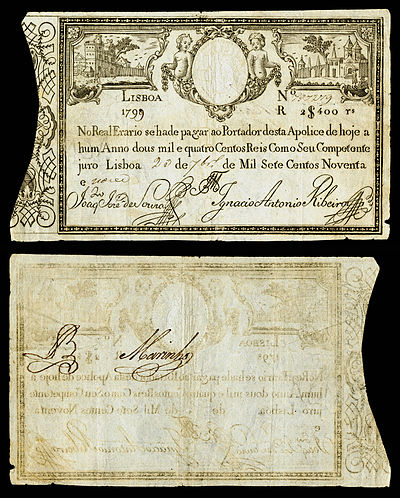Wikipedia:WikiProject Numismatics/newsletter/July 2020/compact

|
The WikiProject Numismatics newsletter |
|---|---|
| Issue XIII | |
Read the full newsletter here
Operation Bernhard was an exercise by Nazi Germany to forge British bank notes. The initial plan was to drop the notes over Britain to bring about a collapse of the British economy during the Second World War. The first phase was run from early 1940 by the Sicherheitsdienst (SD) under the title Unternehmen Andreas (Operation Andreas, Operation Andrew). The unit successfully duplicated the rag paper used by the British, produced near-identical engraving blocks and deduced the algorithm used to create the alpha-numeric serial code on each note. The unit closed in early 1942 after its head, Alfred Naujocks, fell out of favour with his superior officer, Reinhard Heydrich.
The operation was revived later in the year; the aim was changed to forging money to finance German intelligence operations. Instead of a specialist unit within the SD, prisoners from Nazi concentration camps were selected and sent to Sachsenhausen concentration camp to work under SS Major Bernhard Krüger. The unit produced British notes until mid-1945; estimates vary of the number and value of notes printed, from £132.6 million up to £300 million. By the time the unit ceased production, they had perfected the artwork for US dollars, although the paper and serial numbers were still being analysed. The counterfeit money was laundered in exchange for money and other assets. Counterfeit notes from the operation were used to pay the Turkish agent Elyesa Bazna—code named Cicero—for his work in obtaining British secrets from the British ambassador in Ankara, and £100,000 from Operation Bernhard was used to obtain information that helped to free the Italian leader Benito Mussolini in the Gran Sasso raid in September 1943.
In early 1945 the unit was moved to Mauthausen-Gusen concentration camp in Austria, then to the Redl-Zipf series of tunnels and finally to Ebensee concentration camp. Because of an overly precise interpretation of a German order, the prisoners were not executed on their arrival; they were liberated shortly afterwards by the American Army. Much of the output of the unit was dumped into the Toplitz and Grundlsee lakes at the end of the war, but enough went into general circulation that the Bank of England stopped releasing new notes and issued a new design after the war. The operation has been dramatised in a comedy-drama miniseries Private Schulz by the BBC and in a 2007 film, The Counterfeiters (Die Fälscher). (Full article...)
The Hudson Sesquicentennial half dollar is a fifty-cent piece struck by the United States Bureau of the Mint in 1935 as a commemorative coin. The coin was designed by Chester Beach. Its obverse depicts the Half Moon, flagship of Henry Hudson, after whom the city of Hudson is named. In addition to showing the ship, the coin displays a version of the Hudson city seal, with Neptune riding a whale, a design that has drawn commentary. Although the city of Hudson was a relatively small municipality, legislation to issue a coin in honor of its 150th anniversary went through Congress without opposition and was signed by President Franklin D. Roosevelt, becoming the Act of May 2, 1935. Most of the coins were likely bought by coin dealers, leaving few for collectors, with the result that prices spiked from the $1 cost at the time of issue. This caused collector anger, but did not lower the coin's value, which has continued to increase in the 80-plus years since it was struck. (Full article...)
Picture of the Day April 13

(see more)
New members are automatically added to the subscriber list • If you are not a member and would like to receive this newsletter, or are a member but would not like to receive future issues, you may subscribe/unsubscribe here
Delivered by ZLEA via ~ at ~~~


